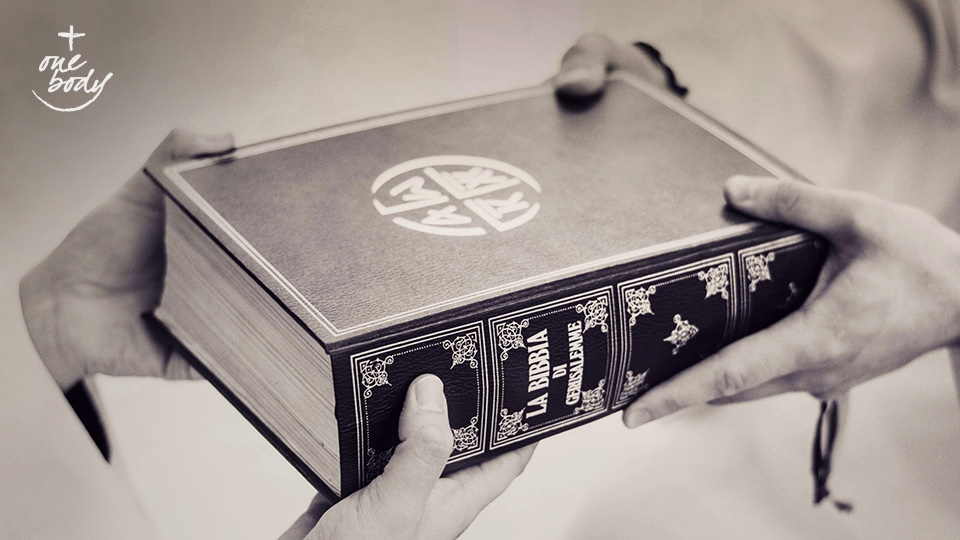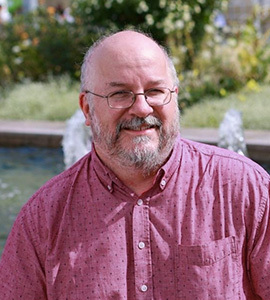

The Universal Priesthood and Synodality | One Body
Nicholas Jesson
Thursday, July 6, 2023

Photo by Vytautas Markunas SDB on Cathopic.

The Universal Priesthood and Synodality
by Nicholas Jesson
“Though they differ from one another in essence and not only in degree, the common priesthood of the faithful and the ministerial or hierarchical priesthood are nonetheless interrelated: each of them in its own special way is a participation in the one priesthood of Christ” (Lumen Gentium, #10).The reports issued during the diocesan and continental phases of the Synod on Synodality 2021-2024 offer a consistent call for a renewed understanding of the universal or baptismal priesthood. These reports frequently refer to the Vatican II quotation above, reminding us that 60 years ago, the church began to chart a new path in which the laity are not passive observers of the clergy’s active ministry. At times over the intervening years, lay ministry has been deemed a collaboration in what was typically understood as clerical ministry. The very word “ministry” has been frequently denied to lay people, who were instead meant to have an apostolate in the world. Pope Francis’ call to end clericalism has not meant an end to ordained ministry. He has cautioned against moves to clericalize lay ministry, pointing instead to the baptismal dignity of all. The Synod participants have noted the scriptural foundations for a baptismal priesthood.
The Priesthood of All Believers
Differing views on lay ministry can be traced back to the Reformation. Each reformer approached the issue differently, but consistently argued for a “priesthood of all believers.” Citing 1 Peter 2:5-9, they argued that all believers, as a “holy priesthood,” have a priestly role, are called to make spiritual sacrifices, proclaim the good news of Jesus Christ, and participate in the worship and service of God. Similarly, Romans 12:1 calls upon Christians to offer themselves as a “living sacrifice.” Every believer is called to offer their lives to God in union with Christ, our High Priest. The “priesthood of all believers” was presented by the Reformers in contrast to the medieval church that had become clerical with an emphasis on the sacrament of orders and the rights and privileges of the ecclesiastical caste. The Counter-Reformation rejected a priesthood of all believers with a reassertion of the ministerial priesthood of the ordained. It should be noted that the diaconate also suffered a diminishment during the medieval and Reformation periods, being relegated to a transitional stage towards the fullness of ministry in the ordained priesthood. Even the bishop’s role was diminished in this period as it came to be seen as a particular priestly function: the bishop's local authority was at times understood as a delegation of the pope's universal authority.Vatican II and Beyond
It was only at Vatican II that proper understandings of the three orders of ministry were developed, and opened up a concrete practice of lay ministry. The Council therefore offers a point of reference for further expansion by the Synod on Synodality. Lumen Gentium #10 highlights the participation of the laity, who belong to the universal priesthood, in the secular realm. It emphasizes their role in sanctifying the world through their daily activities, and bringing the Gospel’s values to their respective professions and social spheres. In #12, the Council affirms that the entire body of the faithful, as part of the universal priesthood, shares in Christ’s prophetic office, emphasizing the faithful’s role in bearing witness to Christ through their lives of faith, charity, and worship. It also acknowledges the guidance and protection of the Holy Spirit in matters of belief. Speaking of the lay apostolate, #31 emphasizes that all the faithful, through their baptism and confirmation, are commissioned by the Lord to participate in the mission of the church. It recognizes that the sacraments, particularly the Eucharist, nurture the charity central to the church’s apostolic mission. Following the Council, further affirmations of the universal priesthood can be found. St. John Paul II, in his apostolic exhortation Christifideles Laici (1988), emphasized the vocation and mission of the laity in the church and the world. He affirmed the universal priesthood of the faithful, and their role in the evangelization and transformation of society. In his encyclical Deus Caritas Est (2005), Pope Benedict XVI highlighted the connection between the eucharist and the universal priesthood. He emphasized that through the eucharist, the faithful are united to Christ and empowered to live out their priestly mission of love and service.A Fruit of Dialogue
Ecumenical reflection on the universal priesthood can be found in numerous places:- The Baptism, Eucharist, and Ministry (“BEM,” 1982) text from the World Council of Churches is foundational for ecumenical discussions on ministry. It recognizes the universal priesthood of all believers as an essential doctrine held in common by many Christian traditions. BEM explores the biblical basis of the priesthood and provides a theological framework for understanding the relationship between the universal priesthood and the ordained ministry.
- The Gift of Authority (1998) from the Anglican-Roman Catholic International Commission examines the nature of authority within the church. It discusses the concepts of the universal and ministerial priesthood in the context of the authority to teach, govern, and sanctify. The document exemplifies a common ecumenical consensus that situates the ministry of the whole people of God in a broader understanding of the church’s mission.
- The Church: Towards a Common Vision (2013), also from the World Council of Churches, begins where BEM ended. It aims to provide an ecumenical convergence on the nature and mission of the church, proposing the priesthood of all believers as a critical element. It recognizes the diversity of ministerial structures within different Christian traditions, while affirming the shared responsibility of all believers to participate in the life and ministry of the church.
- Synodality and Primacy in the First Millennium: Towards a Common Understanding in Service to the Unity of the Church (2016) was published by the Joint International Commission for Theological Dialogue between the Roman Catholic Church and the Orthodox Church. The document explores the historical and theological aspects of synodality and primacy in the early church, focusing on the first millennium of Christianity. It seeks to deepen the common understanding between the two traditions regarding the relationship between synodality and primacy (the role of the bishop of Rome and the patriarchs). Although this document understands synodality in broad terms, its focus on the bonds of communion between bishops is similar to the Vatican II concept of the collegiality of bishops.
- A very recent text by the same dialogue explores the second millennium. Titled Synodality and Primacy in the Second Millennium and Today (2023), the document concluded that “the interdependence of synodality and primacy is a fundamental principle in the life of the Church” and that this principle “should be invoked to meet the needs and requirements of the Church in our time” (#5.4, 5.5).
The Synod on Synodality
Recent reflections on synodality have placed a renewed emphasis on the universal priesthood. Synodality, in recent Catholic discussions, refers to the participation and collaboration of the whole people of God, including both clergy and laity, in the life and decision-making processes of the church. Like the concept of the universal priesthood, synodality affirms that the Holy Spirit works through the entire community of believers, and that their input and discernment are essential for the church’s mission and governance. It emphasizes the shared responsibility of all believers to contribute their gifts, insights, and experiences for the discernment of God’s will. It seeks to foster a culture of dialogue, listening, and collaboration within the church, where the voices of all the faithful, both clergy and laity, are valued and taken into account. The Synod office in Rome has recently published the Instrumentum Laboris, or working document, for the first session of the Synod in October 2023. It places the issues of lay ministry, ordination of women, and the renewal of clerical ministries on the agenda, situating them within a discussion on “co-responsibility in mission.” “Mission constitutes the dynamic horizon from which we are to think about the synodal Church” (#51). In #54, it affirms that “A missionary synodal Church has a duty to ask itself how it can recognise and value the contribution that each Baptised person can offer in mission.” A priority for the church that “discovers itself as missionary and synodal concerns the manner in which it is able to solicit the contribution of all, each with their gifts and roles, valuing the diversity of charisms and integrating the relationship between hierarchical and charismatic gifts” (#54). In addition to a theological outline of the themes raised during the diocesan and continental phases of the Synod, the Instrumentum Laboris also includes a series of worksheets to guide the Synod discussion. Worksheet B2.2 affirms that baptismal dignity is the foundation of everyone’s participation in the church. Baptismal dignity is linked to a common or universal priesthood as the root of all baptismal ministry. The common and ministerial priesthood are “interrelated” since each, in its own way, is a “participation in the one priesthood of Christ” (Lumen Gentium, #10). The local church is the place where participation in all of Christ’s priesthood, both baptismal ministries and the particularity of ordained ministries, are most fruitful. Worksheet B2.2 calls for a new impetus to lay participation in evangelisation in social, cultural, economic, and political life, while enhancing the contribution of consecrated lay men and women within the local church. The ministry of women was raised in all of the continental reports and in a great majority of the diocesan reports of the Synod. Worksheet B2.3 frames the discussion by affirming the baptismal dignity of all: “In Baptism, the Christian enters into a new bond with Christ and, in Him and through Him, with all the Baptised, with all humanity and with the whole of creation.” Rooting the ministry of women in a common baptismal vocation is consistent with Vatican statements going back to St. John Paul II’s 1988 apostolic letter Mulieris Dignitatem. The common affirmation of the diocesan and continental reports of the Synod indicates the need for a more concrete realisation of the equal dignity of all in the life of the church “through relationships of mutuality, reciprocity, and complementarity between women and men.” In this quote from the Worksheet, we see how the Instrumentum Laboris studiously avoids drawing conclusions on matters of continuing discussion. “Complementarity” refers to the idea that women and men have distinct roles in life, ministry, and family that are rooted in the complementarity of the sexes. It is left to the Synod members in October to determine whether and how to develop the discussion of women’s ministry along paths of mutuality, reciprocity, or complementarity.Concluding remarks
In conclusion, I want to say a brief word about the serious undertaking of the Synod on Synodality as a whole. Vatican II taught us that the whole people of God are united in baptism and called together to be participants in Christ’s priestly, prophetic, and kingly ministry. Now, consider this in light of the Council’s teaching on the sensus fidei or “sense of the faith.” The sensus fidei is something like the conscience. In Catholic theology, the conscience is a supernatural gift, an instinct, by which we recognize good and evil. The sensus fidei is a supernatural gift as well, but both an individual gift and a collective gift given to the whole people of God. The sensus fidei is preserved from error when, under the guidance of the Spirit, the faithful demonstrate universal agreement in matters of faith and morals (Lumen Gentium, #12). Just as the church teaches that the pope and the church are infallible through the teaching of the magisterium, so too are the whole people of God through the discernment of the sensus fidei. Papal infallibility is defined in the documents of Vatican I and Vatican II, and there have been many libraries written about the way that infallibility might be exercised. Vatican II did not offer the same guidance on how to recognise the sensus fidei. According to the teaching of Pope Francis, synodality is how we seek the sensus fidei. This is the way that the whole church will engage together in discernment of how the Spirit is speaking to us in scripture, Tradition, and the “signs of the times.” When Pope St. John XXIII announced the Second Vatican Council, he indicated that it would be a time to open the church’s windows and let the wind of the Spirit blow away the cobwebs and other accretions that have built up over time, obscuring the Gospel and the holy Tradition. He used an Italian word, aggiornamento, which means something like “updating.” In the Synod preparations, it is not surprising that the wind blowing through the church has raised many issues that have not been discussed or that have been taboo. The challenge for the continuing synodal process is to tell which of these are cobwebs and which are the “signs of the times” about which Vatican II spoke. To quote the Synod Secretariat in Rome, the synodal process is intended to facilitate a free consultation that listens to the Spirit, “who like the wind ‘blows where it wills; you can hear the sound it makes, but you do not know where it comes from or where it goes,’ (John 3:8) remaining open to the surprises that the Spirit will certainly prepare for us along the way” (Preparatory Document, #2). Nicholas Jesson is both the Synod coordinator and the ecumenical officer for the Archdiocese of Regina. He is currently a member of the Anglican-Roman Catholic Dialogue in Canada and of the Canadian Council of Churches’ Commission on Faith & Witness, editor of the Margaret O’Gara Ecumenical Dialogues Collection, and editor of the Anglican-Roman Catholic Dialogue archive IARCCUM.org. He was ecumenical officer for the Diocese of Saskatoon (1994-99 & 2008-17), executive director of the Prairie Centre for Ecumenism (1994-99), and member of the Roman Catholic-United Church of Canada Dialogue (2012-20).
Nicholas Jesson is both the Synod coordinator and the ecumenical officer for the Archdiocese of Regina. He is currently a member of the Anglican-Roman Catholic Dialogue in Canada and of the Canadian Council of Churches’ Commission on Faith & Witness, editor of the Margaret O’Gara Ecumenical Dialogues Collection, and editor of the Anglican-Roman Catholic Dialogue archive IARCCUM.org. He was ecumenical officer for the Diocese of Saskatoon (1994-99 & 2008-17), executive director of the Prairie Centre for Ecumenism (1994-99), and member of the Roman Catholic-United Church of Canada Dialogue (2012-20).Related Articles:
>>
SUPPORT LABEL
$50
$100
$150
$250
OTHER AMOUNT
DONATE
Receive our newsletters
Stay Connected
Receive our newsletters

Stay Connected









